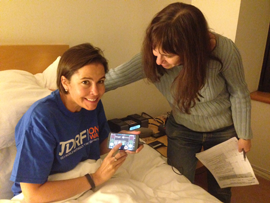The best interrupted night’s sleep ever
Brian: For the past three nights, several highly educated adults have tucked us into bed after connecting us to an algorithm that knows our blood sugars better than we do. Is this real life? Is this what you expected?
Alecia: Not exactly. I didn’t realize how the switch to closed loop artificial pancreas (AP) system would actually happen. I imagined it would literally be as easy as flipping a switch. Not so. At 8:00 p.m., two hours after eating dinner, we switch the Bluetooth connection from linking the insulin pump and the meter to linking the continuous glucose monitor (CGM), insulin pump, and Diabetes Assistant (DiAs), which is the cellphone device with the algorithm that runs the show and calculates how much insulin to give. Then we hang out, closely monitor our blood sugars, have snack time, and wait until 11:00 p.m. when we turn on the closed loop.
As for smarties putting us to bed, it’s totally strange, but comforting to know we are being monitored so closely. We’ve had so much bonding time with the AP team, being put to bed is just part of the routine. I only wish they’d read us a bedtime story.
Brian: We definitely should have demanded a story. And warm milk and cookies (though that would definitely interfere with the parameters of this trial. But that would be an excellent way to test the system. I digress.) It was strange when they followed me into my bedroom the first night. But once we are paired to the DiAs, finally hitting the “start closed loop” button is so, SO exciting. The first night, I got misty when I was finally hooked up to the system that I’ve been hearing about and working and fundraising towards for years.
Alecia: Did you immediately trust the algorithm? Any hesitations?
Brian: The past few days have given me the impression that it has my type 1 diabetes figured out better than I do. And it only took it 15 minutes. Remarkable.

Alecia: I’ll admit it, every time I wake up I’m compelled to check the DiAs screen. I’m just so curious. Last night, my blood glucose level was elevated after dinner and regrettably held that “too high” level. Because we can’t turn on the “closed loop” unless our blood sugars are between 80 and 250 mg/dL, I was forced to walk on the hotel’s treadmill in an effort to bring my glucose level down. It worked beautifully, but my BG was still dropping at the 11 p.m. closed-loop start time. I watched the DiAs from my bed as the dropping BG glided to a perfect horizontal line, hovering in the 120 mg/dL range. It was mesmerizing to watch and realize those algorithms were truly working.
Are you getting used to the 3 a.m. blood checks?
Brian: I did think we’d be sleeping a little better. I don’t know if I’ll ever get used to people waking me up at 3:00 a.m. to test my blood sugar. I don’t mind terribly, but I’m not my most congenial self in the middle of the night, so I hope I’m not too grumpy to the team, who I’m actually growing rather fond of. But when this is finally FDA approved, I know I will get that perfect sleep. But for now, a good night’s sleep is still my white whale.
Alecia: I wish I could fall back asleep after the 3:00 a.m. blood check. but being tired is a tiny price to pay. It’s so unbelievable to think that WE are contributing to the betterment of diabetes care. I feel a huge sense of responsibility to make sure I’m checking and double-checking that I follow all the procedures and eliminate any variables that could skew the results. It’s been more work than I’d anticipated but truly fascinating to see everything firsthand.
Brian: This whole process has been eye-opening. There are so many dedicated people involved, from the Mt. Sinai and UVA endocrinologists and certified diabetes educators to the technicians to the computer programmer—so many brilliant people working to make my life better. (And your life, too.) I feel like they should film this and air it as a reality show. I would watch that.
With two nights left, what are you looking forward to as we wrap this up?
Alecia: As we get further into the trial, the AP team is showing us how to set up and manage the devices a bit more ourselves. I want to learn as much as I possibly can and especially try to understand more of the mechanics.
Brian: Me too. We’re going to be controlling these eventually. I want to see what that’s going to be like.
Read Brian and Alecia’s previous blog post
JDRF’s Clinical Trials Connection provides people affected by type 1 diabetes (T1D) and its complications with up-to-date information on clinical trial participation opportunities.
Clinical Trials Connection is an online service that allows you to “opt-in” to get information about trials, and access to them. It contains information about all currently active diabetes trials in the U.S and U.K. Based on the criteria you choose, the connection provides you with information about selected trials and how to contact the researchers conducting them. You can also choose to receive regular updates so that you’ll know when new trials that meet your criteria become available. If you find a trial that interests you, you can discuss it with your doctor and also contact the trial’s primary investigator with any questions or concerns.